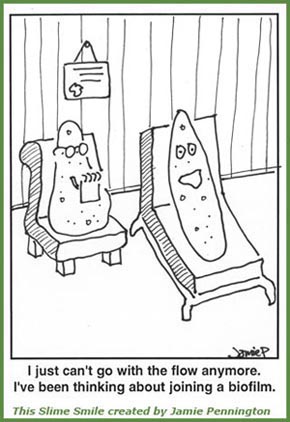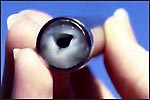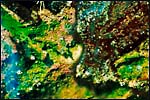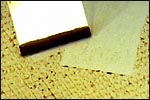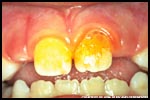A substantially updated version of the hypertextbook is available here. Please migrate to that version. This one will eventually disappear.
Objectives
The objectives of this section are:
to introduce you to the concept of biofilms;
to let you know why the study of biofilms is important;
to help you see how biofilms are radically changing the way we understand and deal with many microbiological issues;
to excite you about the prospects of the continued study of biofilms.
Outcomes
By the time you have completed this section you will able to:
describe in general terms what a biofilm is;
discuss the importance of biofilms;
explain how knowledge of biofilms has radically changed the way we view problems and treatments with respect to microorganisms that affect industry, medicine, dentistry, and the environment;
contribute to public awareness of biofilms.
What are biofilms?
|
|
|
|
About Section 1
In this section we introduce the topic of biofilms. Even this short section should give you enough understanding of the biofilm phenomenon for you to begin to make sense of the issues that biofilms raise with respect to the study of microorganisms and their effects on the earth, on industry, and on human health.
Background
Biofilms? What are biofilms? And why would you be asked to study biofilms? Presumably, if you are learning about this topic here on the green track in this hypertextbook, you are new to the concept of biofilms, and possibly new to biology as well. Indeed, you might be a brand new student all around, just trying to find your way (kind of a fun time of life, isn't it?). In any case, unless you were watching carefully along the way, it is unlikely that you have encountered the term biofilm up to now.
In this introductory section we let you know what biofilms are and why you are studying them. We trust that when you are done learning about biofilms here, you will leave with an appreciation of the following issues:
- Biofilms are a natural part of the ecology of the earth.
- Many biofilms are quite harmful (for example, when they show up as infections in wounds) and must be treated or controlled.
- Other biofilms are beneficial and can be used to help fix serious problems (such as ground contamination from an oil spill).
- Yet other biofilms are not perceived as either bad or good, but rather are recognized to be an important part of the natural environment around us.
Most of all, from this introduction to biofilms, we hope you take with you a clear understanding of this fact:
- The study of biofilms represents a radical new way of understanding the microbiology of virtually everything around us, from problems that afflict industry to serious public health issues. Along with this new understanding comes an exciting opportunity for a new generation of researchers and practitioners: the opportunity to rethink our strategies for dealing with biofilm problems and solutions that in the past were overlooked or not handled correctly, because no one recognized that biofilms were involved. The potential to do immense good for our world as a whole is held out to those who enter this field.
Indeed, we secretly hope (whoops, there goes the secret) that you will find the topic of biofilms so interesting and challenging that you will become interested in their study as a career choice. Biofilms represent a new, wide-open field of practice and research that is only going to get hotter with time. You are, in fact, among the first college students to actually learn about biofilms in a formal course.
A brief introduction to biofilms
Even though you may not be familiar with the term biofilm, you have certainly encountered biofilms on a regular basis. For example, the plaque that forms on your teeth and causes tooth decay is one type of bacterial biofilm. The "gunk" that clogs your household drains is also a biofilm. If you have ever walked in a stream or river, you may have slipped on rocks that were slimy with biofilm. A persistent infection on a scrape you got from a sports injury was likely a biofilm. And so it goes: biofilms—they're where you want to be.
So what is a biofilm?
A biofilm is composed of living, reproducing microorganisms, such as bacteria, that exist as a colony, or community. In other words, biofilms are alive and have a complex social structure that scientists and engineers are still trying to unravel, a structure that both protects them and allows them to grow.
How do biofilms form?
A biofilm forms when certain microorganisms (for example, some types of bacteria) adhere to the surface of some object in a moist environment and begin to reproduce. The microorganisms form an attachment to the surface of the object by secreting a slimy, glue-like substance. Biofilms can form on just about any imaginable surface: metals, plastics, natural materials (such as rocks), medical implants, kitchen counters, contact lenses, the walls of a hot tub or swimming pool (did you ever notice that the sides of a hot tub or swimming pool seemed slightly slimy?), human and animal tissue, and on and on. Indeed, wherever the combination of moisture, nutrients, and a surface exists, biofilms will likely be found as well.
A biofilm community can be formed by a single kind of microorganism, but in nature biofilms almost always consist of mixtures of many species of bacteria, as well as fungi, algae, yeasts, protozoa, and other microorganisms, along with non-living debris and corrosion products. For example, over 500 bacterial species have been identified in typical dental plaque biofilms!
How big can a biofilm get?
Biofilms can be so thin as to avoid detection by the naked eye—just a few cell layers thick. The biofilms that almost certainly exist on your kitchen counter, for instance, are generally undetectable to the eye (unless, like some college students, you don't wash your counters very often). They can also grow to become many inches thick; probably not on a countertop (at least we hope not), but certainly as algae on rocks in a streambed.
What makes a biofilm stick together?
Engineers and scientists have discovered that biofilms are held together by sugary molecular strands, collectively termed "extracellular polymeric substances" (a mouthful of a term that essentially means "compounds or substances that form outside the walls of cells") or "EPS." The cells produce strands of EPS and are held together by these strands, allowing them to develop complex, three-dimensional, attached communities that are resistant to attacks that would destroy individual cells not part of a biofilm colony.
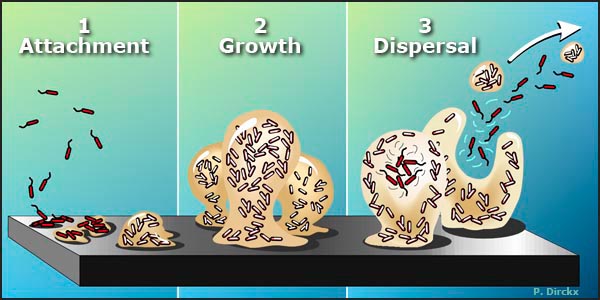
Figure 1. The Biofilm Life Cycle.
1. Free-floating, or planktonic, bacteria encounter a submerged surface and within minutes can become attached. They begin to produce slimy extracellular polymeric substances (EPS) and to colonize the surface.
2. EPS production allows the emerging biofilm community to develop a complex, three-dimensional structure that is influenced by a variety of environmental factors. Biofilm communities can develop within hours.
3. Biofilms can propagate through detachment of small or large clumps of cells, or by a type of "seeding dispersal" that releases individual cells. Either type of detachment allows bacteria to attach to a surface or to a biofilm downstream of the original community.
How can harmful biofilms be treated?
Ah! Now here we get to the crux of the biofilms issue. Read this little section carefully, because when you get the point here, you will understand why the study of biofilms is so radical and important, and the rest of this hypertextbook will make sense to you. You see, the effective treatment (i.e., destruction) of harmful microorganisms, such as bacteria, has been studied for many long years from the wrong perspective! That's right. Harmful microorganisms were studied (and still are, unfortunately, to a large extent) in isolation, not as members of a biofilm colony, where they actually normally reside.
Let's discuss this by way of an example. Have you ever heard of, say, a mouthwash that is advertised to "kill millions of germs on contact?" That is probably a truthful statement from the mouthwash company (hey, we aren't trying to run anyone out of business; however, we would like to help them do their business better). But now consider this. Those millions of germs are embedded in a plaque biofilm in your mouth. Just how does the mouthwash penetrate the biofilm to actually contact each of those millions of individual germs? Good question. Remember that we said that biofilms can become quite thick, and that they seem to have the capacity to form defensive mechanisms against outside attacks.
The fact is that today's mouthwashes, antibiotics, household cleaners, disinfectants, and most other treatment formulas were developed by testing their effect on harmful microorganisms in a planktonic state (a state in which microorganisms float in a solution as individuals, not as part of a biofilm colony attached to a surface). So, although such treatments may indeed kill millions of germs on contact, the effect of these treatments is severely limited when they are applied to real world environments in which the microorganisms to be killed are actually members of a biofilm.
The conclusion, and one that is currently being aggressively pursued by biofilm researchers around the world, is that the entire study of the treatment of harmful microorganisms must be revisited in the light of this new understanding of how those microorganisms actually present themselves in our environment: as biofilms. The structure, growth, defense mechanisms, reproduction, and all other facets of biofilms must be understood, and new treatments and methods for evaluating the effectiveness of those treatments must be developed.
These are the grand challenges facing those who enter the field of biofilms. Much progress has already been made, but there is a lot more to understand and do, both in terms of developing effective treatments and in educating society about biofilms and their implications. That is why we say that this is a good field for young people to consider as a career focus in biology, microbiology, environmental engineering and science, biochemistry, and other disciplines.
Oh, and let's finish the story about the mouthwash. Given what is known about dental plaque now, you would have to gargle with a good mouthwash for about five minutes straight to kill off those millions of germs present on teeth coated with an "average" amount of plaque.
Some interesting history
Biofilms were actually observed long ago, before science was well formed and people had the tools to study them in detail. In 1684 Anthony van Leewenhoek remarked on the vast accumulation of microorganisms in dental plaque in a report to the Royal Society of London: "The number of these animicules in the scurf of a man's teeth are so many that I believe they exceed the number of men in a kingdom." In a 1940 issue of the Journal of Bacteriology, authors H. Heukelekian and A. Heller wrote, "Surfaces enable bacteria to develop in substrates otherwise too dilute for growth. Development takes place either as bacterial slime or colonial growth attached to surfaces." It was not until the late decades of the 20th century, however, that scientists and engineers possessed adequate technology to effectively study microbial communities and began to understand the significant implications of the biofilm mode of growth.
In some ways it's too bad that this early work did not catch on. For one thing, you just have to love that word "scurf" used by van Leewenhoek. It is so much more descriptive and colorful than "biofilm."
Summary
The study of biofilms has skyrocketed in recent years due to increased awareness of the pervasiveness and impact of biofilms on natural and industrial systems, as well as human health. Biofilms cost the U.S. literally billions of dollars every year in energy losses, equipment damage, product contamination and medical infections. But biofilms also offer huge potential for cleaning up hazardous waste sites, filtering municipal and industrial water and wastewater, and forming biobarriers to protect soil and groundwater from contamination. The complexity of biofilm activity and behavior requires research contributions from many disciplines such as biochemistry, engineering, mathematics and microbiology. New insights into the mysteries of biofilm are being published daily in a wide variety of science and engineering journals.
As we said, if you find this interesting, there will be a place for you in this exciting and rapidly growing field. Read on.
